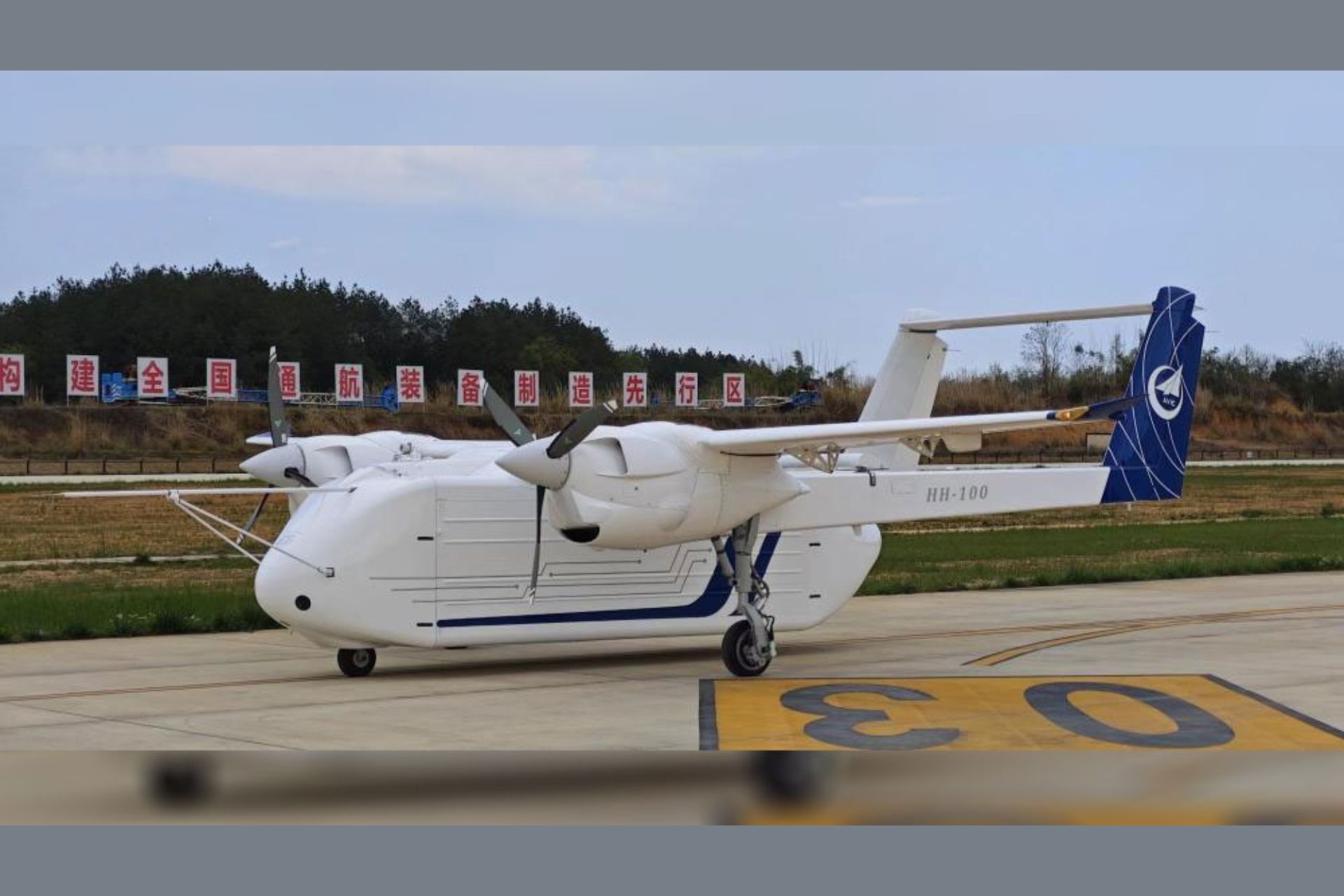Video | China release first video of national made heavy cargo drone

{loadposition bannertop}
{loadposition sidebarpub}
China has unveiled a video of its cargo drone, the HH-100, tested last April, developed by Xi’an Aircraft Industry (a subsidiary of the Aviation Industry Corporation of China (AVIC)), now known to be manufactured by Tengden Industries, a company specialized in the aerospace industry. On April 3rd, the drone conducted taxiing and pre-takeoff maneuvers, and on June 12th, 2024, the HH-100 completed its first flight. This opens up new possibilities for freight delivery in remote areas, with many potential applications for the Chinese military in terms of delivery and even evacuation of the wounded.
Follow Army Recognition on Google News at this link
HH-100 during tests on the taxiway (Picture source CGTN)
With a robust design that supports a maximum takeoff weight of 2,000 kilograms and a payload capacity of 700 kilograms, this local innovation is poised to significantly enhance the speed and efficiency of delivering essential supplies in crisis zones. The taxiing and ground maneuvers were tested in April 2024, and the first flight took place in June 2024.
The HH-100’s operational capabilities allow it to travel up to 2,000 kilometers at cruising speeds of 300 km/h, ensuring rapid delivery of food, medicine, and other critical supplies to affected areas. This range and speed surpass many existing models, enabling quicker reactions to urgent needs, which is crucial during the initial hours following a disaster when roads are often unavailable.
Moreover, the drone’s ability to operate at altitudes up to 5,000 meters makes it particularly valuable in reaching remote or hard-to-access regions often hit hardest by natural calamities. Whether navigating through mountainous terrains or areas cut off by floods, the HH-100 can safely and efficiently transport aid where needed.
Introducing such technology could dramatically cut down the response time in disaster-stricken areas, thereby saving lives and reducing the overall impact of natural disasters. As countries around the world grapple with the increasing frequency and intensity of these events, the deployment of advanced drones like the HH-100 could become a critical component in national emergency management strategies.
China’s development of the HH-100 underscores its commitment to leveraging technology for humanitarian aid. This move enhances its disaster response capabilities and sets a benchmark for global disaster relief efforts. As the world looks towards more innovative solutions to tackle emergency scenarios, drones like the HH-100 are likely to play a pivotal role in shaping the future of disaster response.
This unique drone system combines a UAV with a dedicated ground station. The HH-100 boasts several key advantages: affordability, high cargo capacity, and the distinction of being entirely built using domestically sourced components.
The service is scheduled to begin in the fall of 2024. It represents a solution for natural crises in remote areas, but the drone can also provide a more conventional cargo delivery option. However, it is certain that the drone will reduce transportation costs and human variables. This paves the way for the development of increasingly larger drones, and perhaps even passenger transport drones in the coming years.
HH-100 released video (Picture source X/@Nickatgreat1220)

{loadposition bannertop}
{loadposition sidebarpub}
China has unveiled a video of its cargo drone, the HH-100, tested last April, developed by Xi’an Aircraft Industry (a subsidiary of the Aviation Industry Corporation of China (AVIC)), now known to be manufactured by Tengden Industries, a company specialized in the aerospace industry. On April 3rd, the drone conducted taxiing and pre-takeoff maneuvers, and on June 12th, 2024, the HH-100 completed its first flight. This opens up new possibilities for freight delivery in remote areas, with many potential applications for the Chinese military in terms of delivery and even evacuation of the wounded.
HH-100 during tests on the taxiway (Picture source CGTN)
With a robust design that supports a maximum takeoff weight of 2,000 kilograms and a payload capacity of 700 kilograms, this local innovation is poised to significantly enhance the speed and efficiency of delivering essential supplies in crisis zones. The taxiing and ground maneuvers were tested in April 2024, and the first flight took place in June 2024.
The HH-100’s operational capabilities allow it to travel up to 2,000 kilometers at cruising speeds of 300 km/h, ensuring rapid delivery of food, medicine, and other critical supplies to affected areas. This range and speed surpass many existing models, enabling quicker reactions to urgent needs, which is crucial during the initial hours following a disaster when roads are often unavailable.
Moreover, the drone’s ability to operate at altitudes up to 5,000 meters makes it particularly valuable in reaching remote or hard-to-access regions often hit hardest by natural calamities. Whether navigating through mountainous terrains or areas cut off by floods, the HH-100 can safely and efficiently transport aid where needed.
Introducing such technology could dramatically cut down the response time in disaster-stricken areas, thereby saving lives and reducing the overall impact of natural disasters. As countries around the world grapple with the increasing frequency and intensity of these events, the deployment of advanced drones like the HH-100 could become a critical component in national emergency management strategies.
China’s development of the HH-100 underscores its commitment to leveraging technology for humanitarian aid. This move enhances its disaster response capabilities and sets a benchmark for global disaster relief efforts. As the world looks towards more innovative solutions to tackle emergency scenarios, drones like the HH-100 are likely to play a pivotal role in shaping the future of disaster response.
This unique drone system combines a UAV with a dedicated ground station. The HH-100 boasts several key advantages: affordability, high cargo capacity, and the distinction of being entirely built using domestically sourced components.
The service is scheduled to begin in the fall of 2024. It represents a solution for natural crises in remote areas, but the drone can also provide a more conventional cargo delivery option. However, it is certain that the drone will reduce transportation costs and human variables. This paves the way for the development of increasingly larger drones, and perhaps even passenger transport drones in the coming years.
HH-100 released video (Picture source X/@Nickatgreat1220)





